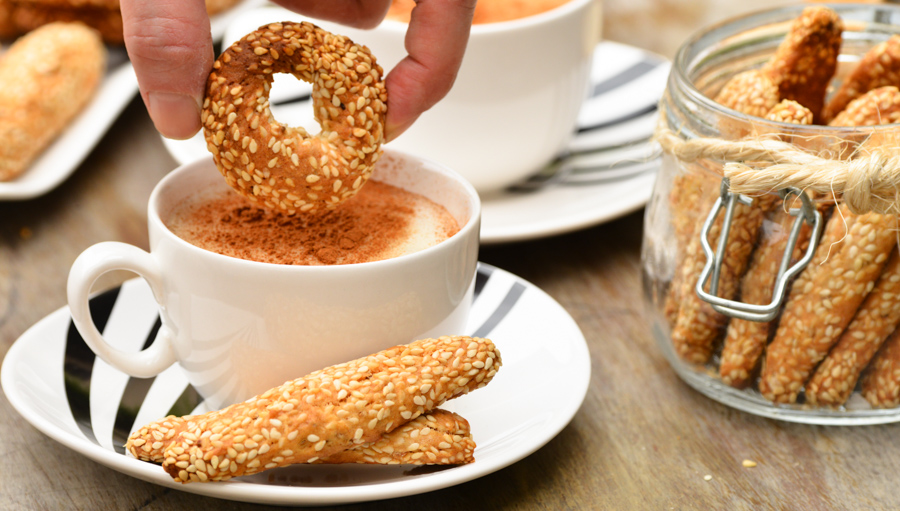
Lebanese Sweet Kaak
Crispy, crunchy Lebanese sweet kaak cookies that pair beautifully with tea, and are perfect too to dunk them in a cup of hot salep, or serve them as part of your afternoon snacks and nibbles! Though to be more accurate, maybe I shouldn’t classify them as cookies, since they are not your ordinary soft, chewy cookies, they are supposed to be a bit hard and crispy with a pleasant crunch in every bite. Seasoned with anise seeds and mahlab, their flavor is warm and fragrant, and are coated with sesame seeds that add a nutty agreeable character; if you have been raised in Lebanon, then you must have seen them gracing the windows of most Lebanese bakeries. Watch the video tutorial to learn how to make them!
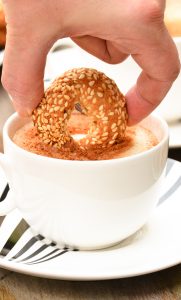
Lebanese Sweet Kaak (Video)
I get enormous satisfaction in putting a lot of time into a recipe, and having it turn out perfect. This is one of the recipes of my cookbook, I remember back then that I had tested more than 20 recipes until I settled on this fast and easy one; a great thing about this recipe is that you don’t need to wait for the dough to rise, mix the ingredients together and you will end up with a sticky dough, directly start shaping your kaak to logs or rings
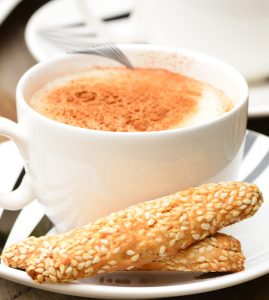
If you have never had kaak, roll up your sleeves and give this Lebanese classic a try. They are not hard to make, even for a beginner baker!
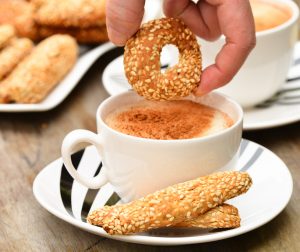
Spices and Seeds
Both anise seeds and mahlab are a great friend to Middle Eastern baked goods, they are the ticket for giving those sweet kaak an extra punch. And a small pinch of fennel seeds adds an agreeable flavor without being overwhelming; sesame seeds provide the kaak with a unique satisfying nutty flavor.
- Mahlab, or Mahleb: an aromatic white spice, used in the Middle East for baked goods.
- Anise seeds: a spice that is native to the Middle East! It has a mild fragrant aroma and a sweet taste that is similar to licorice.
- Dried fennel seeds: are the dried seeds of the fennel herb, highly aromatic, and the flavor is slightly sweet.
- White sesame seeds: Sesame seed is considered to be the oldest oliseed crop known to humanity, a common ingredient in various cuisines. They provide food with a nutty flavor and a little crunch.
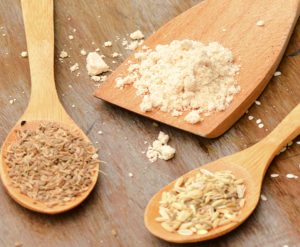
Tips for a successful result:
- Toast the anise seeds a bit in an oil-free skillet, it is worth it to bring out their flavor.
- Use a measuring cup to make the recipe, and level up the flour.
- For a better crunch and more deep flavor, clarify the butter. The milk solids in butter will soften your kaak, which is something we don’t want. Here is a recipe, showing how to clarify butter, or you can simply use ghee(samneh) instead of butter.
- I have tested the recipe with both baking powder and baking soda, I would say the result was great in both, if your favorite kaak is one that is crisp around the edges with a softer center, then go for baking soda. If you prefer it crsipy all the way through, then baking powder would yield better results. My personal preference is baking powder.
- Don’t over knead the dough.
- The dough is meant to be considerably sticky, this helps the sesame seeds to stick easily. If for some reason your dough is on the dry side add a tablespoon of water, not more, and knead gently to incorporate. If the dough is overly sticky, sprinkle just a bit of flour and knead just to integrate the ingredients together.
- Make sure to shape the kaak as equal as possible in size so they bake evenly.
- Use parchment or silicon baking mat, otherwise you need to oil the baking sheet you are using
- For more crunch, bake longer, but beware not to burn the edges.
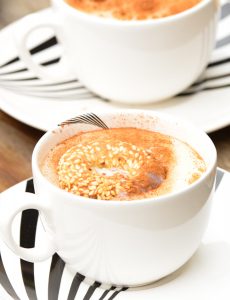
How to make Lebanese sweet kaak?
First off start clarifying the butter, if you are using ghee, skip this step. In a small saucepan, melt butter over medium-low heat. Skim off the white foam that appears on top. Transfer to a small glass container, and set aside for about 10 minutes. You will notice that the milk solid sediment will precipitate to the bottom and a golden liquid will appear on top. Pour the golden liquid, which is called the clarified butter, to a small bowl, and get rid of the white solids on the bottom.
In a large bowl, mix the flour, clarified butter or ghee oil, sugar, anise seeds, mahlab, vanilla extract, baking soda and water, and knead just to obtain a sticky dough. If the dough is on the dry side, add 1 tablespoon of water and mix to incorporate. If the dough is too sticky sprinkle just a bit of flour and knead just to integrate the ingredients together. Divide the dough into equal balls, roughly the size of a ping pong ball, or even smaller.
Rub each ball with the palm of your hands, forming a 7 cm or 2.5 inches long rope like dough. You can keep them that logs, or you can pinch the end of the rope together, forming a circle.
Dip in the sesame seeds, making sure the sesame covers the kaak on both sides. Place on parchment lined cookie sheets, keep some space between one kaak and another. They don’t rise a lot.
Bake in a preheated oven to 200°C/400°F, to a golden color, about 2o minutes.
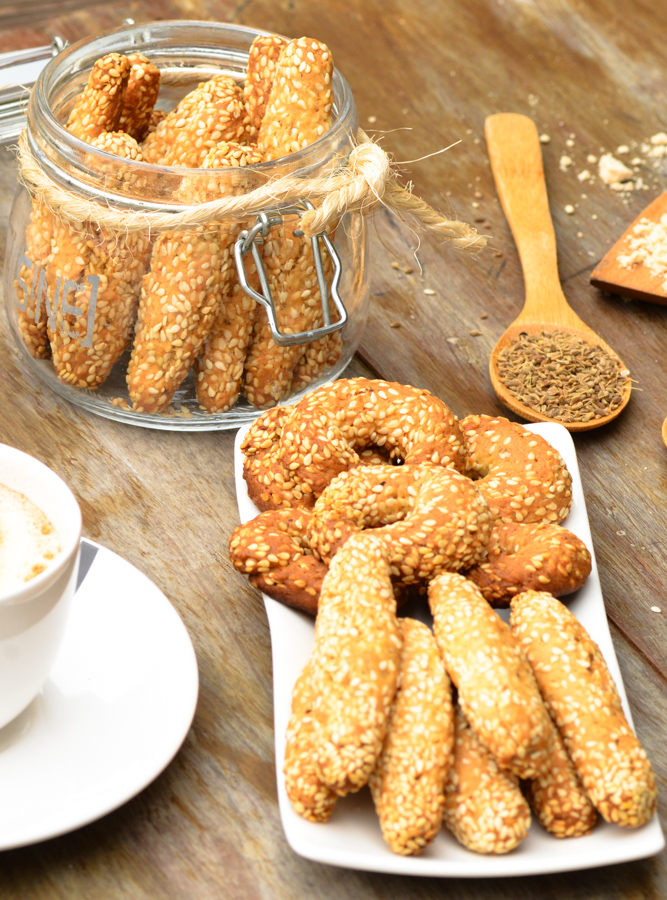
The log shape: Roll each round dough between your palms, until you form an elongated rope shape dough, about 7 cm/2.5 inches. Dip in seame seeds, making sure to coat both sides, ready to go into the oven.

The ring shape: rub each round dough with the palm of your hands, forming a 7 cm or 2.5 inches long rope like dough. Pinch the end of the elongated rope together, forming a circle, I prefer the round kaak. Dip in the sesame seeds, making sure the sesame covers the kaak on both sides, ready to go into the oven.
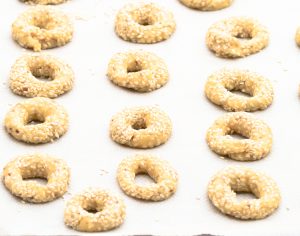
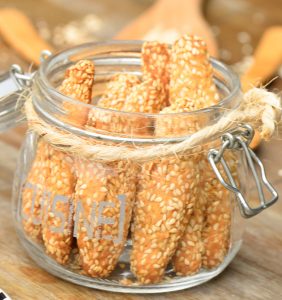
How long can I keep Kaak?
Kaak are dry and they hold up well to storage, but make sure they are completely cool before storing to prevent them from softening. Store in an airlock glass storage container, and they will last for 2 weeks.
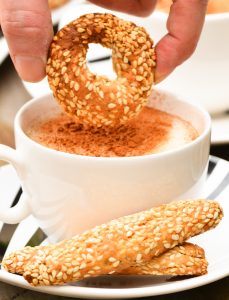
If you have never had kaak, roll up your sleeves and give this Lebanese classic a try. They are not hard to make, even for a beginner baker! Watch the video tutorial above to see how to make them!
Ingredients:
- 2 ½ cups all-purpose flour
- 1/3 cup sunflower oil
- 1/3 cup / 70 g. / 2.5 oz. unsalted butter
- 1 egg, lightly beaten
- ½ teaspoon baking soda, or baking powder, read the tips above to see your personal preference
- 3 tablespoons anise seeds
- 1 tablespoon mahlab
- 1 teaspoon fennel seeds, optional
- ¾ cup sugar
- ½ teaspoon vanilla extract
- ¼ teaspoon salt
- 1/3 cup water, you may need to 1 or 2 tablespoons more water
- 1 cup white sesame seeds
Direction:
- Preheat oven to 200°C/400°F.
- First off start clarifying the butter, if you are using ghee, skip this step. In a small saucepan, melt butter over medium-low heat. Skim off the white foam that appears on top. Transfer to a small glass container, and set aside for about 10 minutes. You will notice that the milk solid sediment will precipitate to the bottom and a golden liquid will appear on top. Pour the golden liquid which is called the clarified butter to a small bowl, and get rid of the white solids on the bottom.
- In a large bowl, mix the flour, salt, clarified butter, oil, sugar, egg, anise seeds, mahlab, vanilla extract, baking soda and water, and knead just to obtain a sticky dough. If the dough is on the dry side, add 1 tablespoon water and mix to incorporate. If the dough is too sticky sprinkle just a bit of flour and knead just to integrate the ingredients together.
- Divide the dough into equal balls, roughly the size of a ping pong ball, or even smaller. roll each round dough between your palms, until they form an elongated rope shape about 7cm/ 2.5 inches long. Dip in seame seeds, making sure to coat both sides.
- To make the ring shape kaak, rub each ball with the palm of your hands, forming a 7 cm or 2.5 inches long rope like dough. Pinch the end of the elongated rope together, forming a circle, I prefer the round kaak. Dip in the sesame seeds, making sure the sesame covers the kaak on both sides. Place on parchment lined cookie sheets, keep some space between one kaak and another. Bake to a pale golden color, about 20-25 minutes. Keep an eye on your oven, and remember that ovens are different! Happy eating! Watch the video tutorial above, to learn how to make them!

You might also like to learn about the quintessential Lebanese street bread, another great recipe “Kaak/ Kaak Alasreya/ “
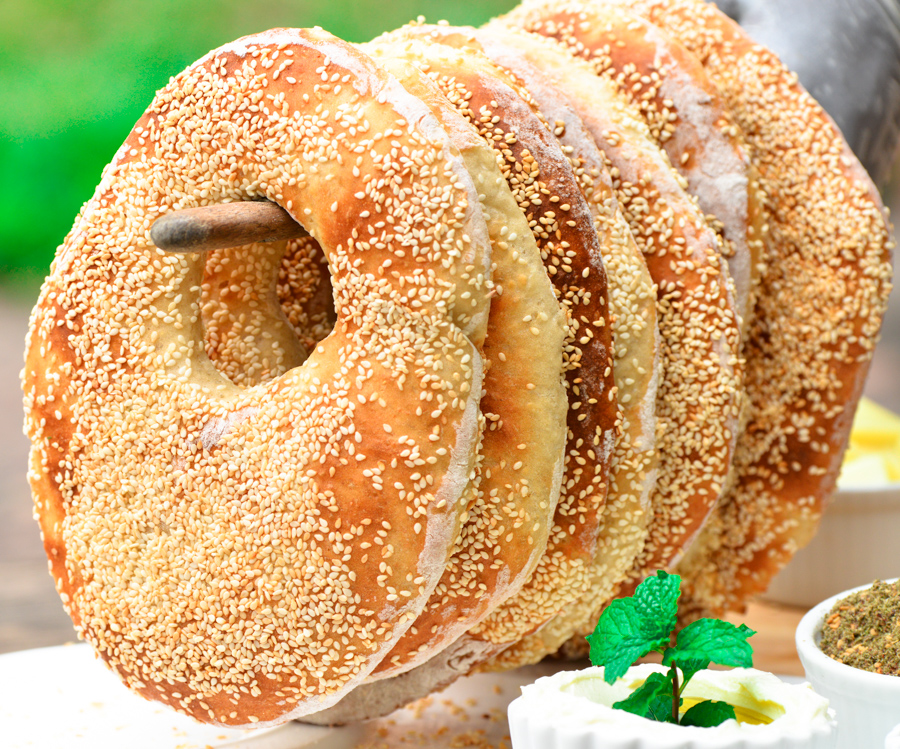
More cookies to enjoy with your morning coffee or afternoon tea:
-
almond paste stuffed cookies
-
chocolate chip crescent cookies
-
black and white pinwheel cookies
-
date filled ghraybeh
If you make this recipe, leave a comment below or share your pictures on Facebook! I would love to see your creations!Hashtag them #Hadia’s Lebanese Cuisine

The book is now available, with free shipping for prime members on Amazon, grab a copy! Available for order also: Antoine Online
Subscribe to Our Newsletter
Instructions
No Steps Found !
- Course : APPETIZERS, BREAKFAST, DESSERTS, Snacks
- Recipe Type : APPETIZERS, APPETIZERS, BreakFast, BREAKFAST, DESSERTS, DESSERTS, LEBANESE RECIPES, RECIPES FROM AROUND THE WORD, Snacks
- Ingredient : kaak, Sesame Seeds
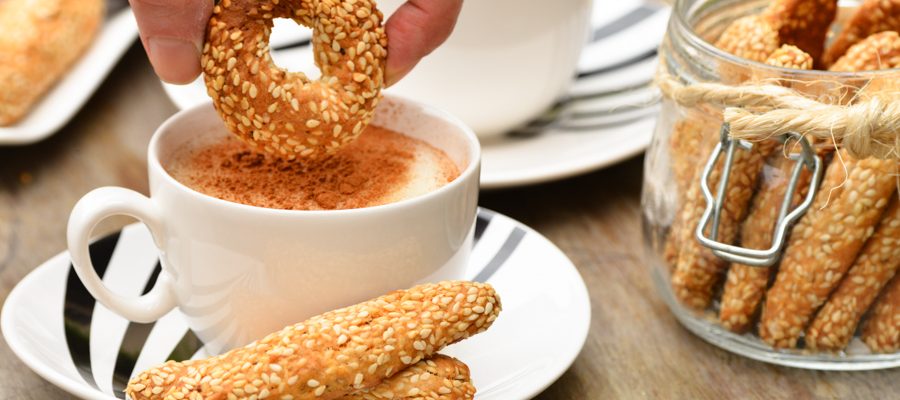
14 Responses to Lebanese Sweet Kaak
Leave a Reply to Julie Menghini Click here to cancel reply.
About Chef
Hadia Zebib
I am Hadia, the face behind Hadia’s Lebanese Cuisine. I grew up in Beirut Lebanon and I currently reside in Kinshasa, Congo with my husband and my three adorable sons, ...
Read more about this chef..

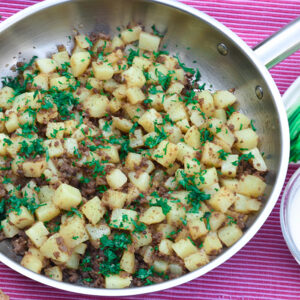
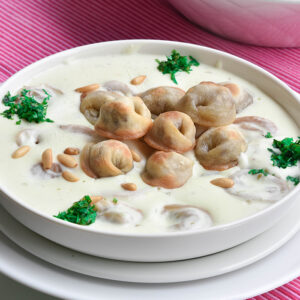
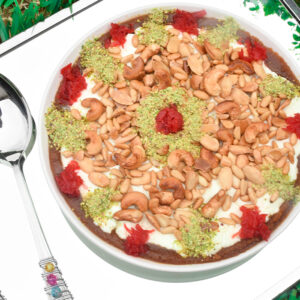


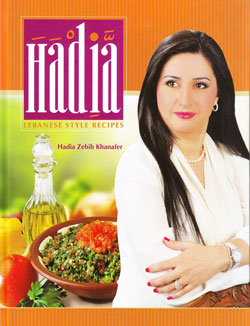
Surprised how good these were, though I am not a dough person, made the ring shaped and used baking powder,option, super crunchy and yummy. I am wondering if I can double the recipe. Thank you Hadia for another great recipe.
Thank you, Rhonda! So happy to hear it! Indeed it a great recipe, I too prefer the baking powder option, I like the crunch in those kaak! And yes absolutely the recipe can be doubled with great results.
These little bites are perfect for tea! I love that they’re small and will be perfect for having the girls over.
My mom loved baking sesame seed cookies!! And I loved eating them. These sweet gems look delicious!
I love cookies that can be dunked in a nice cup of tea and I love the flavours in your kaak. Hadia your pics are beautiful.
Hi Haida, these were my favorite growing up and now I want to make my own but I’m plant based for health reasons. Do you have a good alternative for the butter and the egg?
Hi Mary, yes, we grew up eating this, and it is doable without an egg, but after much testing, I would say the recipe as I exactly posted yields best results. I can understand the fact that you need it vegan, then I would say omit the egg and butter and instead of putting 1/3 cup oil, put 2/3 cup. Sahtain, Mary.
Hi Hadia…love your book. I’m a Maltese Australian and have found a huge similarity in foods, especially the sweets, with Maltese cuisine.
We make date filled pastries, both baked and fried..called im-qarret and the Smeet and crunchy kaak, which we spell as qaq.
I’m now doing a search to find this book in Oz.
Great book
Thank you so much for the sweet comment, Catherine, and interesting to know the similarities with Maltese cuisine. Just read something about Imqaret, it is thought to be of Arabic origin and were introduced to Malta during the period between 870 AD and the 11th Century. Xo xo
anybody try to make this with sourdough?
Hi Hadia, if I use ghee, do I also take 70 grams? Or did you measure the butter after clarifying?
Hi Cathy, and sorry for the late answer. I was on vacation. If you are using ghee then 60 grams would be ok. I hope you like it!
Can you please suggest a substitute for sunflower oil? I love baking with ghee can I just use more ghee instead and if so, how much would you suggest? Adore sesame cookies and can’t wait to make them. Have been enjoying your recipes. Want to also try your kibbeh with mahumara too next once I buy ingredients. Thank you!
Hi , and sorry for the late answer. I was on vacation. If you are using ghee then 60 grams would be ok and thank you for the sweet comment, much appreciated!